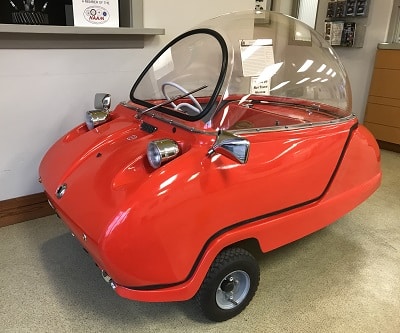
Peel Trident- 2013
Cyril Cannell was a talented engineer, and started Peel Engineering on the Isle of Man in the late 1940s.Cyril was fascinated with the new material called fiberglass (sometimes called...
DAILY DEMONSTRATIONS AT 11AM, FREE WITH ADMISSION!
Please note that the cars or exhibit items shown in this database are part of our collection but may not be on display when you visit.
Cyril Cannell was a talented engineer, and started Peel Engineering on the Isle of Man in the late 1940s.Cyril was fascinated with the new material called fiberglass (sometimes called...
Most people associate Peel Engineering with the building of fiberglass bike fairings and microcars. Peel also made a couple of different car models based on then-current production cars’ running...
The Peugeot 202 was the smallest car made by Peugeot in the pre-WWII era. It had a very stylish and somewhat streamlined body, and sales were very good, with...
In the late 1970s, Peugeot was known as a manufacturer of large, relatively luxurious sedans, but the company was floundering in the global market. Their takeover of both Simca-Talbot...
In 1939, Peugeot introduced their first three-wheeled delivery motorcycle, the “Trimoteur.” It was advertised as “the more economic of the fast means of delivery.” While the rear wheel, seat,...
During the second World War, much of Europe suffered from the lack of gasoline. Peugeot, like many other manufacturers, made a few electric vehicles. The vehicles were austere, to...
Brothers Gilles and Olivier Prévôt began PGO (Prévôt Gilles et Olivier) Automobiles in 1985, but production started in earnest in 2000, building Porsche 356-inspired sports cars. Their first...
Known as the APE (ah-pay), Italian for “bee”, this little three-wheeled workhorse often found itself as busy as its namesake. Designed by the inventor of the Vespa scooter, aircraft engineer...
In 1931, the Polish government signed an agreement with Fiat for license production of the 621 truck and the 508 Balilla small car. The cars were sold through the...
The 2014 50th Anniversary Edition 911 was built by Porsche to commemorate the 911’s birthday, 50 years after its production launch in 1964. In homage to 1963, the year...
Prior to WWII, Ferdinand Porsche was selected by Hitler to design “the people’s car”–the Volkswagen. During the war, Porsche fled to Austria. It was during this time that he...
Volkswagen and Porsche have a shared history going back to the 1930s, beginning with Dr. Ferdinand Porsche and his design, the VW Beetle; it was the mechanical basis for...
Dating back to 1907, Praga is one of the most important Czech makes. The first car to carry the Praga name appeared in 1910 with the slogan “cars which...
PTV was a line of cars produced by Automóviles Utilitarios S.A., a Spanish company based near Barcelona. While it was much closer to being a “real” car than the...
Emerging from Brazil in the 1960s, the Puma GT quickly gained acclaim as a respected sports car. Designed by Rino Malzoni, its sleek fiberglass body and aerodynamic form provided...
In 1953, Reliant Engineering Co. brought out their first passenger car–the Regal. Reliant chose this name in recognition of the Coronation of Elizabeth II, also in that year. All...
In 1962, the Renault 4CV was replaced by another back-to-basic car, the Renault 4. It was no secret that the R4 was aimed at giving the Citroën 2CV some...
In 1898, Alfred Renault, choosing not to go into the family button business, built a small car in a workshop in the garden of his family’s home. The “Type...
Renault introduced its frugal 5 model to the European market in 1972. It was one of the first “superminis”; larger than a Mini, but smaller than a VW Beetle...
In 1972, Renault brought out, a front-engine, front-wheel-drive, 3-door hatchback called the Renault 5. By the time the original 5 was replaced in 1984, nearly 5.5 million had been...
The 4 cylinder Renault Alpine 310 was launched in 1972. Some consider the Alpine one of France’s best kept secrets–it was a more practical and cheaper alternative to the...
In 1985, Renault redesigned the 310 series. This GTA is larger and more rounded. It has a 6 cylinder engine. This car is very light (1800 pounds) and quite...
Avantime is a combination of the French “avant” for “ahead” and the English word “time”. The Avantime’s predecessor – the Espace – was certainly ahead of its time. By...
The Renault Sport Clio V6 is one of a long line of sporting Renault designs based on existing economy cars by the Régie. Although clearly the Clio V6 is...
Renault’s Clio is a long-running Supermini-class car. Since 1990, it has been produced in four generations; this is an example of a limited-production model based on the first generation...
In 1956, Renault came out with a new model called the Dauphine. It was essentially an updated 4CV with a larger body and more power. The Dauphine was also...
In 1956, Renault announced the Dauphine, a 4CV development. The mechanics are similar to those of the 4CV, but the body is a 3-box type. It has a welded...
The Espace debuted in 1984, the same year as the Dodge Caravan. Both were pioneers in the Multi-Purpose Vehicle market. Designs for the Espace had been floating around Chrysler...
The Renault Fuego was introduced in 1980 and is considered a car of firsts – the Fuego introduced the first keyless entry fob in the automobile industry; was the...